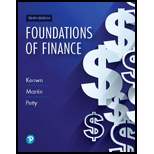
Foundations Of Finance
10th Edition
ISBN: 9780134897264
Author: KEOWN, Arthur J., Martin, John D., PETTY, J. William
Publisher: Pearson,
expand_more
expand_more
format_list_bulleted
Concept explainers
Textbook Question
Chapter 5, Problem 49SP
(Calculating the effective annual rate) You’ve just received an offer from a bank for a credit card with a quoted rate, or APR, of 18 percent compounded monthly. What’s the EAR, or effective annual rate, on the credit card?
Expert Solution & Answer
Want to see the full answer?
Check out a sample textbook solution
Students have asked these similar questions
Please give me answer with financial accounting question
I need help with financial accounting question
Solve this question with financial accounting question
Chapter 5 Solutions
Foundations Of Finance
Ch. 5 - Prob. 1RQCh. 5 - The processes of discounting and compounding are...Ch. 5 - Prob. 3RQCh. 5 - Prob. 4RQCh. 5 - Prob. 5RQCh. 5 - Prob. 1SPCh. 5 - Prob. 2SPCh. 5 - Prob. 3SPCh. 5 - Prob. 4SPCh. 5 - Prob. 5SP
Ch. 5 - (Compound value) Stanford Simmons, who recently...Ch. 5 - (Future value) Sarah Wiggum would like to make a...Ch. 5 - Prob. 8SPCh. 5 - (Future value) Giancarlo Stanton hit 59 home runs...Ch. 5 - Prob. 10SPCh. 5 - Prob. 11SPCh. 5 - Prob. 12SPCh. 5 - Prob. 13SPCh. 5 - Prob. 14SPCh. 5 - Prob. 15SPCh. 5 - Prob. 16SPCh. 5 - Prob. 17SPCh. 5 - Prob. 18SPCh. 5 - Prob. 19SPCh. 5 - Prob. 20SPCh. 5 - Prob. 21SPCh. 5 - Prob. 22SPCh. 5 - Prob. 23SPCh. 5 - Prob. 24SPCh. 5 - (Solving for PMT of an annuity) To pay for your...Ch. 5 - Prob. 26SPCh. 5 - Prob. 27SPCh. 5 - (Loan amortization) On December 31, Beth Klemkosky...Ch. 5 - (Solving for r of an annuity) You lend a friend...Ch. 5 - Prob. 30SPCh. 5 - (Compound annuity) You plan on buying some...Ch. 5 - (Loan amortization) On December 31, Son-Nan Chen...Ch. 5 - (Loan amortization) To buy a new house you must...Ch. 5 - Prob. 34SPCh. 5 - Prob. 35SPCh. 5 - Prob. 36SPCh. 5 - Prob. 37SPCh. 5 - Prob. 38SPCh. 5 - (Compound interest uith nonannnal periods) a....Ch. 5 - (Compound interest with nonannual periods) After...Ch. 5 - Prob. 41SPCh. 5 - (Spreadsheet problem) To buy a new house you take...Ch. 5 - (Nonannual compounding using a calculator) Jesse...Ch. 5 - (Nonannual compounding using a calculator)...Ch. 5 - (Nonannual compounding using a calculator) Fords...Ch. 5 - Prob. 46SPCh. 5 - (Nonannual compounding using a calculator) Dennis...Ch. 5 - Prob. 48SPCh. 5 - (Calculating the effective annual rate) Youve just...Ch. 5 - Prob. 50SPCh. 5 - Prob. 51SPCh. 5 - (Present value) The Kumar Corporation is planning...Ch. 5 - (Perpetuities) What is the present value of the...Ch. 5 - (Complex present value) How much do you have to...Ch. 5 - (Complex present value) You would like to have...Ch. 5 - Prob. 56SPCh. 5 - Prob. 57SPCh. 5 - Prob. 58SPCh. 5 - Prob. 59SPCh. 5 - (Present value of a complex stream) Don Draper has...Ch. 5 - (Present value of a complex stream) Don Draper has...Ch. 5 - (Complex stream of cash flows) Roger Sterling has...Ch. 5 - (Future and present value using a calculator) In...Ch. 5 - Prob. 1MCCh. 5 - Prob. 2MCCh. 5 - Prob. 3MCCh. 5 - Prob. 4MCCh. 5 - Prob. 5MCCh. 5 - Prob. 6MCCh. 5 - Prob. 7MCCh. 5 - Prob. 8MCCh. 5 - Prob. 9MCCh. 5 - Prob. 10MCCh. 5 - Prob. 11MC
Knowledge Booster
Learn more about
Need a deep-dive on the concept behind this application? Look no further. Learn more about this topic, finance and related others by exploring similar questions and additional content below.Similar questions
- I need help with this situation and financial accounting questionarrow_forwardRemaining Time: 50 minutes, 26 seconds. * Question Completion Status: A Moving to the next question prevents changes to this answer. Question 9 Question 9 of 20 5 points Save Answer A currency speculator wants to speculate on the future movements of the €. The speculator expects the € to appreciate in the near future and decides to concentrate on the nearby contract. The broker requires a 2% Initial Margin (IM) and the Maintenance Margin (MM) is 75% of IM. Following € Futures quotes are currently available from the Chicago Mercantile Exchange (CME). Euro (CME)- €125,000; $/€ Open High Low Settle Change Open Interest June 1.2216 1.2276 1.2175 1.2259 -0.0018 Sept 1.2229 1.2288 1.2189 1.2269 0.0018 255,420 19,335 In addition to the information provided above, consider the following CME quotes that are available at the end of day one's trading: Euro (CME) - €125,000; $/€ Open High Low June 1.2216 Sept 1.2229 1.2276 1.2288 Settle Change Open Interest 1.2175 1.2176 -0.0083 255,420 1.2189…arrow_forwardI need help with this problem and financial accounting questionarrow_forward
arrow_back_ios
SEE MORE QUESTIONS
arrow_forward_ios
Recommended textbooks for you
 EBK CONTEMPORARY FINANCIAL MANAGEMENTFinanceISBN:9781337514835Author:MOYERPublisher:CENGAGE LEARNING - CONSIGNMENT
EBK CONTEMPORARY FINANCIAL MANAGEMENTFinanceISBN:9781337514835Author:MOYERPublisher:CENGAGE LEARNING - CONSIGNMENT

EBK CONTEMPORARY FINANCIAL MANAGEMENT
Finance
ISBN:9781337514835
Author:MOYER
Publisher:CENGAGE LEARNING - CONSIGNMENT

What is a mortgage; Author: Kris Krohn;https://www.youtube.com/watch?v=CFjY-58ooi0;License: Standard YouTube License, CC-BY
Topic 10 Accounting for Liabilities Mortgage Payable; Author: Accounting Thinker;https://www.youtube.com/watch?v=EPJOphrbArM;License: Standard YouTube License, CC-BY